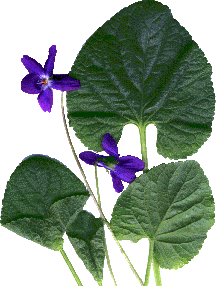


I like them best in salads or used like lettuce in sandwiches. The leaves and flowers make a salad beautiful and much more nutritious.
If you must cook them, you can use them like okra to thicken
soup. Or add them to omelets. Or try some old colonial favorites,
candy them by dipping them in beaten egg white and then into powdered sugar.
Then set them out to dry. Violet vinegar was made by soaking violet
flowers in vinegar.
 Crushed
violets have been used as poultices for boils, swellings and many skin
diseases.
Crushed
violets have been used as poultices for boils, swellings and many skin
diseases.
The mountain violet Viola purpurea is also called "johnny-jump-up" has a yellow front and purple back is edible.
Pansies a botanicaly similar plant are also edible, if they have not been poisoned with pesticides.
Some violets are rare or endangered so make sure that the violets you eat are abundant.
